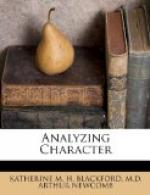At first glance, Dean Schneider’s method of investigation seems sound and his statement, therefore, conclusive. He examined actual cases; he collected evidence, and he found that physical characteristics were not a reliable guide to aptitudes and character. It is well for us, however, to remember in discussing problems of this kind, that every new scientific discovery has always been rejected by many recognized authorities after what they considered to be careful and convincing tests. Harvey nearly died in trying to maintain his theory of the circulation of the blood; Darwin’s theory was insistently repudiated and rejected by many scientific men of his day; Galilo, Columbus, Boillard, the discoverer of the convolution of Broca, and Stevenson, the inventor of the steam locomotive engine, failed to convince the recognized authorities of their times. Gall, who localized the motor functions of the brain, a discovery universally accepted by all brain physiologists today, was laughed out of court by men of the highest scientific authority, who, by experiments, “proved” that he was wrong. So great a mathematician and scientist as Professor Simon Newcomb made the emphatic remark that the dream of flight in a heavier-than-air machine was absurd and would never be realized. The difficulty with all these conclusions lay in the fact that the much-vaunted “proof” was negative in character. Nothing is easier—or more fallacious, logically—than to “prove” that a thing is not so. The difficulty lies in proving that it is so; therefore, logically sound.
According to logicians, conclusions based upon negative premises are inherently unsound. In order to reach reliable conclusions, we must first have all of the essential facts in the case. We question seriously whether this was possible in the course of such a brief investigation as Dean Schneider made. Scientific selection of employees according to the science of character analysis by the observational method was first proposed in the summer of 1912, so that Dean Schneider has had only three years, during which he was much occupied with other duties, in which to make his observations. We only wish here to raise the question as to whether, in that short time, he could obtain all of the facts necessary for reaching a final conclusion. At any rate, other scientists have spent at least fifteen or twenty years in the examination of the same facts before reaching their conclusions.
The method employed as outlined in the paragraph quote does not seem to fulfill all of the necessary requirements of a careful and complete scientific investigation. Take, for example, the test of “directive money-making executives.” Would Dean Schneider, or any other engineer, permit a layman, no matter how well qualified otherwise, to examine twenty or thirty different pieces of engineering work for the purpose of determining whether or not they “conform to any law.” We acknowledge Dean Schneider’s ability as an engineer and as an educator, but until he has submitted proof, we must question his ability and training as an observer of physical characteristics as indicative of character and aptitudes.




